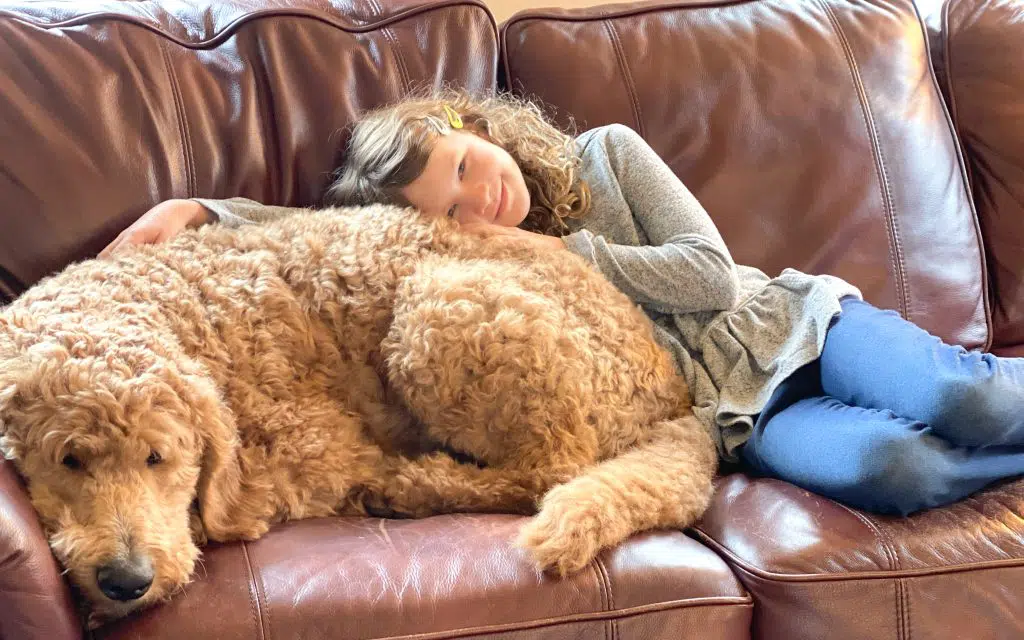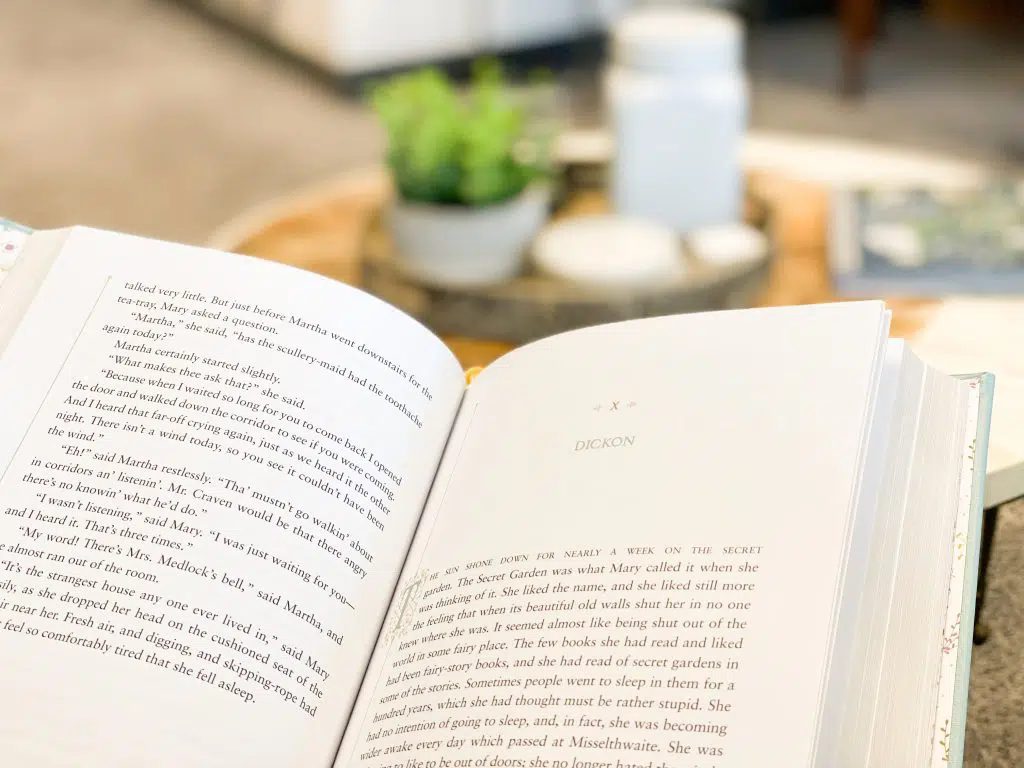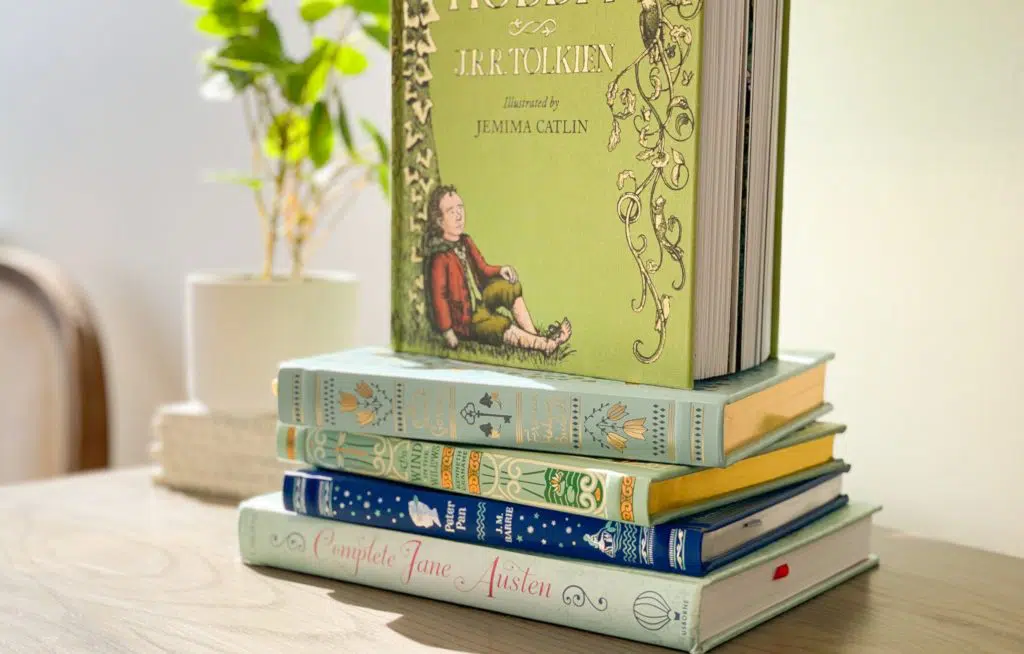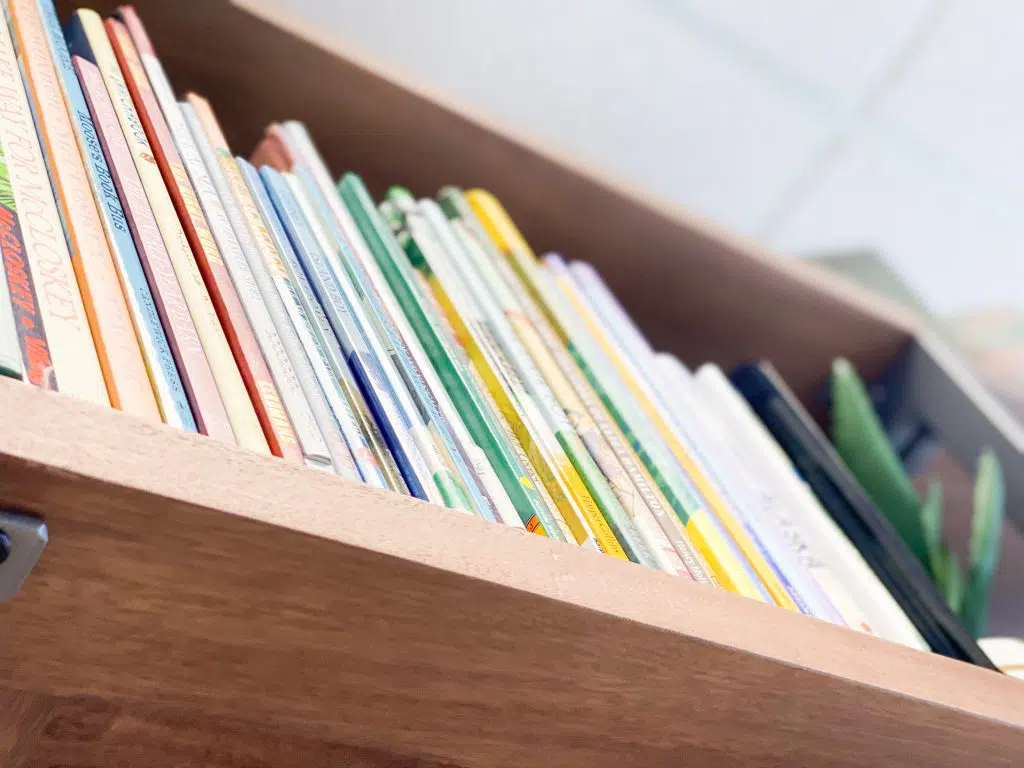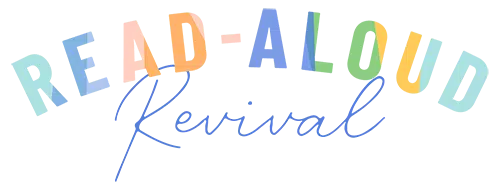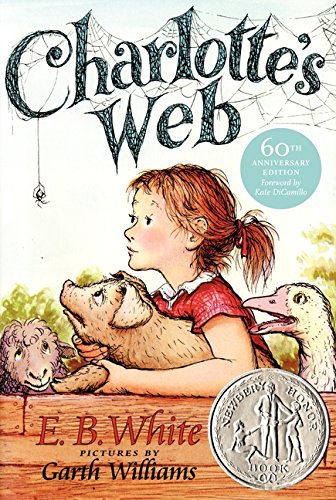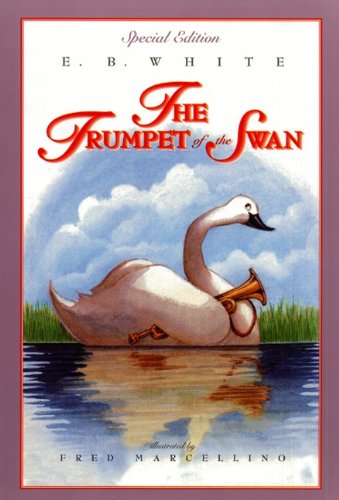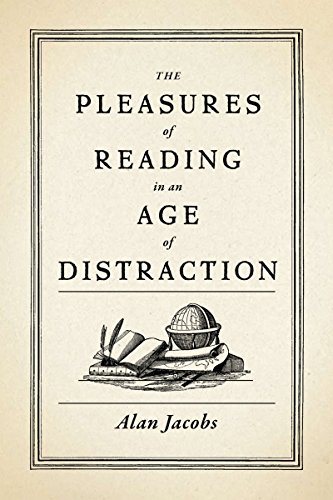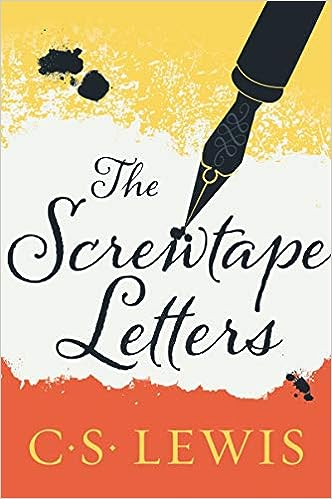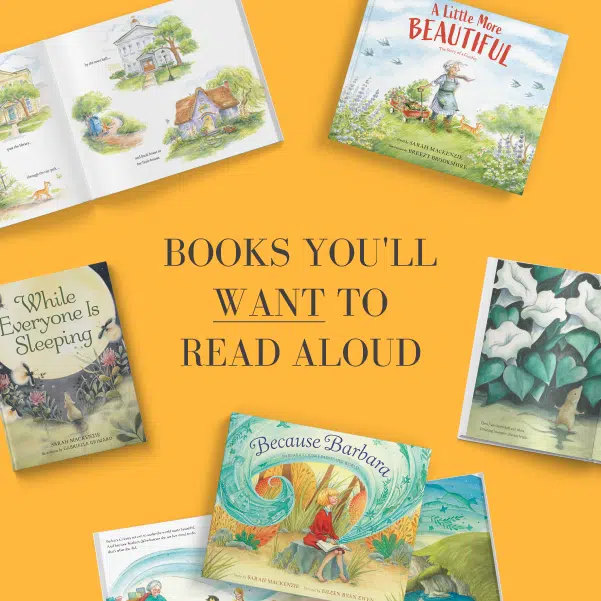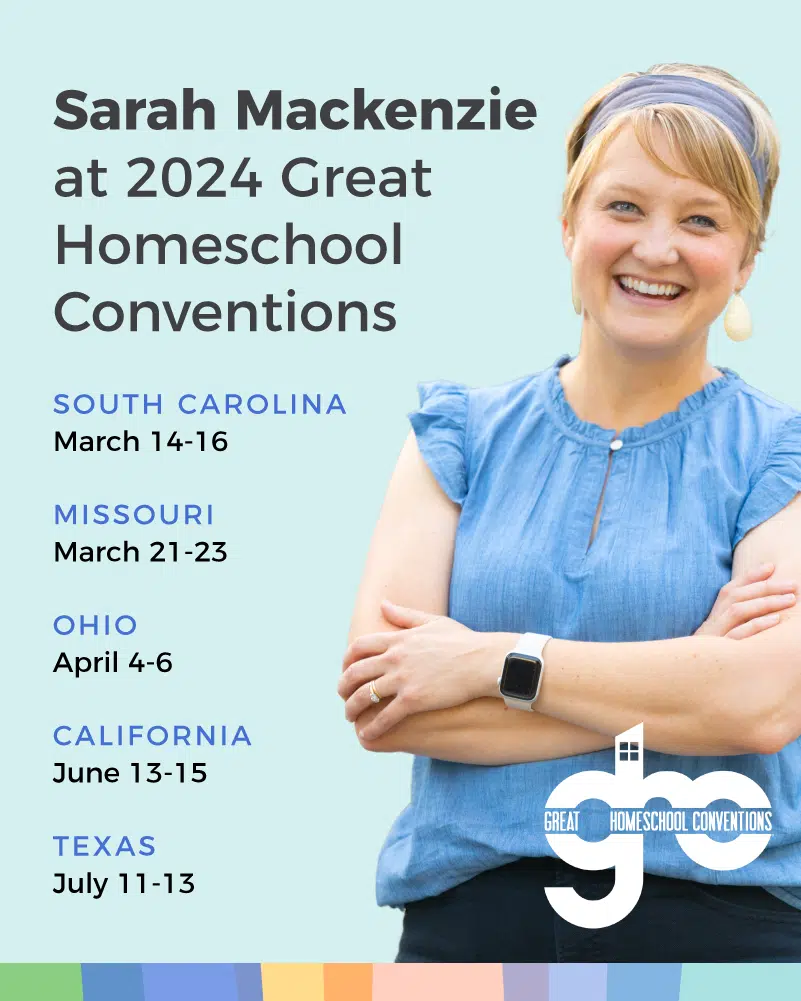Sarah Mackenzie (00:00):
Today, let’s talk about how to make our kids’ reading lists smaller. No, you did not hear me wrong. I’m glad you’re here and keep listening because today on the show, we’re going to talk about what it could mean for your kids’ reading lives and for your reading life too, to focus on reading fewer books and making that reading time more enjoyable and richer and more relaxed and leisurely. We’re going to talk about how to fall more in love with your reading life and how to know when your kids are reading enough.
(00:39):
You’re listening to the Read-Aloud Revival Podcast. I’m your host. Sarah Mackenzie, homeschooling mama of six, an author of The Read-Aloud Family and Teaching from Rest. As parents, we’re overwhelmed with a lot to do. It feels like every child needs something different. The good news is you are the best person to help your kids learn and grow and home is the best place to fall in love with books. This podcast has been downloaded 7 million times in over 160 countries. So if you want to nurture warm relationships while also raising kids who love to read, you’re in good company. We’ll help your kids fall in love with books and we’ll help you fall in love with homeschooling. Let’s get started.
(01:30):
Well, if you’ve listened to the Read-Aloud Revival Podcast for long, or maybe you’ve heard me speak at a conference, you might have heard me field the question I often get at the end of my session or on the podcast. And that question is: How many books should my nine-year-old be expected to read in a school year? Or, how many books should my 14-year-old or my high school senior or any age at all… Fill in the blank. How many books should my child be expected to read in a school year? In fact, how do I know that we’re enough? It’s a question a lot of us ask. And today I wanted to suggest that we ask a different question altogether. Maybe even that we look at this in a different way so we can figure out what’s really going on when we ask it.
(02:17):
The question of how many books should my kid read, or how many books should I be reading? It focuses on this idea… It’s sort of based on this idea, that reading a certain number of books is the goal. So then if reading a certain number of books is the goal, then quantity is the thing to focus on, right? But that’s not actually true. You’re not a better read person. You’re not more well read because you speed read 10 books than someone who read three carefully and thoughtfully and well. You’re not getting more out of your books simply because you’ve read a taller stack of them. So the number of books that our kids read and that we read, so this is true for our kids and it’s true for us, it matters a lot less than the quality of our reading. And I don’t just mean quality of books, like the best classics or the most important books with the biggest ideas. I mean, how much did you enjoy it? How much did you get from it? How much richer is your life now that encountered the ideas in that book?
(03:21):
Not every book that we read is equally formative for us and it’s not for our kids either. So we don’t actually need to read every single book. We shouldn’t read, let me clarify that, every single book with a singular focus on “getting the most out of it”. As Sir Francis Bacon has this great quote that, “Some books are to be tasted, others to be swallowed, and some few to be chewed and digested.” Some few to be chewed and digested. I will just make sure you heard that last bit because not a massive stack of books to be chewed and digested. Some few.
(04:01):
Now, before we get much further down this road, I want to take a second here to emphasize that when our kids are learning to read and they’re developing speed and fluency and comprehension, the number one thing they can do to become better readers… Well, the number one thing they can do outside of being read-aloud to, of course, is to read a large quantity of words. So in that case, if you’ve got a child who’s new to reading and they might be five, they might be nine. It depends on when your child learns to read. Depending on when your child learns to read, just after they’ve kind of started getting the basics of sounding out and decoding words. And now we’re trying to increase their speed and fluency and get them out of those early reading books to a wider variety of reading material. What we actually want in that stage is in fact, a large quantity of words. So we do actually want those developing readers to read stacks and stacks of easy books and quantity in that case is actually a boon. It’s the benefit. That’s where series come in.
(05:11):
I’ve actually done a whole podcast episode on using series books to help your developing reader fall in love with reading and get better at reading. I’ll put a link in this show notes if that’s something where your ears just perked up and you went, “Hey, I’ve got a kid in that stage.” Go check out episode 172. I’m a big, big fan of the read a ton of books that are easy for you to read and you’ll become a better, stronger reader idea. And that’s a key part of our kids’ reading development. This idea when they’re going from just learning how to read, to becoming good readers, to where it’s easy to read. At this point in your life, you don’t have to think about the sounds that letters make when you read a sentence, you just read it.
(05:57):
So there’s this in-between stage between when kids are decoding and when they are able to just read without thinking about how to decode and what the actual letters sounds make and all that. And during that small window of development, we do actually want them choosing tons of books themselves, reading below their grade level, focusing on reading a lot, because the more quantity of words they read, the better and faster they get at reading. And then the better and faster they get at reading, the more they enjoy it.
(06:30):
That’s not the phase I’m talking about. And that’s kind of a relatively small window of time, but I’m really talking more about when you are looking, let’s say at a homeschool curriculum or a literature curriculum, or maybe your child goes to school and they come home with this really long list of books that are assigned as a part of their school. Maybe it’s a part of history curriculum you’re using in your homeschool, or you attend a homeschool co-op or group that has a long list of books that your child is going to be assigned to read in the coming year. Especially this happens a lot as kids get older into the middle school and high school years. That’s more of what I want to key into today, or even this idea of focusing on a quantity of books. A lot of summer reading programs will do this or these programs that reward kids for reading a larger quantity of books. And I really want to talk about this today, because I think this is an important conversation to have.
(07:28):
First of all, I want to tell you, I am very, very, very, very… It’s hard to emphasize the very here. I’m very skeptical of homeschool curriculum and literature programs that have long lists of books to read each year, either really long lists of books for the parent or teacher to read aloud, or long lists of books for older kids and high schoolers to read.
(07:52):
Now, we have book lists at Read-Aloud Revival and you might be thinking, “Hello, Sarah, your book lists are pretty long.” And our book lists are long, but they’re not intended to be read through. When we give you a list of great picture books for Christmas or great books about 18th century America, we’re not telling you should read every book on this list. We’re presenting it like a menu. Pick a few, pick a couple and read from this list. What I’m more concerned about is when I see a curriculum that has a long list of books that all the kids, all the students are going to read through. This happens a lot with homeschool curriculum, happens a lot with literature classes, happens a lot in classical education. So just kind of a heads up that this is something we want to think about.
(08:38):
If you show me a list of let’s say 15 books that your high schooler is supposed to read this school year, I’m going to have a hard time jumping on board with that because my own experience homeschooling my own six kids. And then with all these conversations I’ve had with thousands of homeschooling parents over the years, they’ve convinced me that when we assign a long list of books to a student or any list, honestly, of books to a student, the list instantly becomes a to-do list. And the goal automatically shifts from reading the book to completing the book.
(09:27):
I want to sit with that for a minute. That is an important distinction. Reading a book versus completing book. Reading a book means we’re actively reading it. We’re in the middle of it. We’re in the thick of it. We’re spending time with the book. We’re reading and thinking and considering. Completing a book means we finished reading it and we’re ready to move on to something else. And the reason I think this distinction matters is because a whole lot of us accidentally operate out of an idea that the goal of reading is to finish books.
(10:03):
Let’s think about this for a minute. You read Canterbury Tales. Excellent. Check it off your list of assigned books. Now onto the next one. You’ve read Charlotte’s Web. Great. You’ve finished it. You’re with it. Now onto the next one. This idea of finishing books feeds… This idea of creating a list, makes our book list into a to-do list. And any to-do list, the goal is to be done with it. That is exactly why we call it a to-do list because the goal is to be done with it. And this idea feeds an approach to books that means we can be finished with a book, that we’ve “done the book”. But all the benefits that we get from reading, increased comprehension and fluency, improved brain connectivity, better vocabulary, increased empathy, better sleep, stress reduction, better overall academic achievement. I can keep going. All these benefits we get from reading, they happen from the time, we get them because of the time we spent reading, not because of the number of books we completed. So your reading life is going to be richer if you spend more time reading, but it’s not necessarily going to be richer because you finished a larger quantity of books. Let me kind of try and illustrate what I mean here.
(11:26):
Let’s just take a season or a quarter. I don’t know how you organize your school year, but let’s just say spring. And you could make it your plan to assign your child three books to read this spring, or maybe your homeschool curriculum, your history program, your homeschool co-op whatever, they’ve assigned that your child’s going to read four books this spring. Is that going to be a richer experience than if you were to read one with your student and you loved it and cherished it and sort of read it leisurely and underlined passages from it, or maybe you read it and then you listened to the audio version. Or just listened to the audio version and watched the movie version. Or maybe you read a couple of books, but one of those you read more slowly and carefully and leisurely and thoughtfully. You’re chewing on it like Sir Francis Bacon said. And then the other books, they can be more shallow. They’re just passing over the pages, reading them, getting lost in the story, but not spending as much time deep diving into it.
(12:27):
Here’s the thing. You retain more when you’re fully engaged. So your goal needs to be spending time reading. And this is true for your kids too. Your goal for your kids is for them to spend time reading, not to complete the book. So when you sit down for your reading time each day and you think, “My goal is to spend 30 minutes with my book today.” Not, “My goal is to finish this book. How much closer can I get to being done with it?” Just a healthier way to approach reading, because it’s kind of weird to make the goal being done with the book.
(13:03):
Let’s sit with this for a second. If our primary purpose and goal in parenting was to be done spending time with our kids, it would probably make it difficult to enjoy spending time with your kids. Making it a goal to be done with reading, done with a book, making it a goal to be done with the enjoyable thing, that’s how we should approach like cleaning the bathrooms. Let’s make it a goal on my to-do list to be done cleaning the bathroom because I want the bathroom clean. I’m not necessarily going for soul nourishment and character development. I mean, I guess some of that’s in there anyway, but it’s not one of life’s greatest delights and one of the most important parts of my child’s education, but reading is.
(13:47):
So I think when our goal shifts to spending time reading, rather than reading a certain number of titles or a certain list of titles, then we can breathe easier. We can enjoy it more. We won’t worry if we picked up a super long book or a hard book that needs to be read and reread because we can enjoy it and marinate with it and really, truly engage with it. And instead of worrying about how we’re not going to have time to read all the books that are on our list this year, we can read The Lion, the Witch and the Wardrobe. And then listen to it on audio, and then watch the movie, and really sink our teeth into The Lion, the Witch and the Wardrobe so that it becomes one of our kids’ best companions, childhood companions, and a truly memorable reading experience. That’s a whole different kind of reading than trying to read through a list so that we have “done” The Lion, the Witch and the Wardrobe, plus five other books that our kids may or may not remember because it wasn’t an enjoyable leisurely experience.
(14:50):
So our goal shifts to spending time reading, and then we can just breathe easier and enjoy it more and have more great conversations about it.
(15:01):
I had this experience, just this school year with my 16-year-old. We read The Screwtape Letters by C.S. Lewis. We actually listened to it on audio, which is a slower way to read any book by the way. So if you choose to listen to the audio book, it’s going to be a slower reading experience because pretty much everybody, except for maybe a developing reader, can read faster with their eyes than they can with their ears because we skip words when we’re reading with our eyes. We up all those little connector words and our brains make all kinds of connections. So if I handed you a sheet of paper and said, “Read this page quietly to yourself or silently to yourself,” you could read that faster with your eyes silently than you could if I asked you to read it aloud.
(15:46):
So we decided to listen to the audio book of The Screwtape Letters. And yes, that longer than if I had just assigned him to read a certain number of chapters every week, but I wanted to enjoy it number one, together. And I wanted to make sure we took time with it because if you’re not familiar with The Screwtape Letters, it is a satire, it’s an epistolary novel. So it’s written all through letters and it’s basically from a demon to his underling, his nephew, who is a demon in training whose main course of life, his main purpose in life is to keep his pupil or patient… I can’t remember what they call him, from getting to heaven. And it’s so good. I’ve read it multiple times in my life. But I listened to it with my 16-year-old and we really enjoyed it. And then when we got to the end, we started it over and listened to it again.
(16:39):
And when I did that and I told my son, “Okay, we’re going to listen to it again,” he looked at me kind of strange at first and said, “We are?” And I said, “Yeah. I mean, I think there’s a lot of things we might have missed the first time around and I just think we’re going to catch more. I think it’ll be really enjoyable to listen to it again.” So we got out of puzzle and we would listen to it again. And we listened to it twice in a row.
(17:01):
Now, if I was concerned about my son’s 11th grade year and making sure we were reading a large stack of books, I would not feel like I had the time or freedom to do that, to do it on audio, because that takes a long, and to do it on audio twice. But I’ll tell you what, there were so many things that we both missed the first time around and it wasn’t even my first time around. I’ve probably read it something like eight times now. It was amazing to me how much we missed the first time. It also amazed me our conversations, even though they were great the first time we listened to it, they were even better and richer the second time around. And this is something that I would not have been able to give my 11th grader if I was worried about getting through a whole bunch of books this year.
(17:49):
But because I’ve picked three, I picked one per season that I really wanted to dive in and enjoy with my 11th grader. And that’s his literature education, is we’re reading three books well. And then he’s got reading time, he’s got a reading hour every day, and he reads on his own lots of other books, business books, literature, books, fantasy, all kinds of stuff. Historical fiction. All kinds of stories and nonfiction books. That’s for his own personal independent reading time. But for our main literature time, what we do is we share three books over the course of the year, and The Screwtape Letters was one of them.
(18:28):
And again, if I had a big, long list, like a lot of those high school curricula I look at, a lot of that homeschool curricula is very overwhelming to me. I would not have felt like we had the time or luxury to really sink our teeth into The Screwtape Letters. And we would’ve missed out on a very memorable experience. I can almost guarantee that 10 years from now, if you ask my son, “What did you read? What’re some of your favorite books you read in high school?” I can nearly guarantee that’s going to be one of them that he’ll name because it was such a good experience for both of us.
(19:10):
Now, speaking of rereading, since we reread The Screwtape Letters. If you missed it, in episode 141, I shared why rereading is possibly the best reading. And in that episode, I mentioned that when we love a movie or when we enjoy a movie, it’s completely normal to watch it again. Think right now of one of your favorite movies. How many times have you watched it? I bet most of you did not just think once, because if you love Anne of Green Gables, or A Little Woman, or Lord of the Rings or whatever your favorite movie is, you probably don’t just watch it once. Now, would you think that you are getting more from movies if you had only watched that one once and you had watched a whole list of others? I mean, that’s just not how we think about… If you really love a movie, you re-watch it because you know you’re going to enjoy it and get a different layer and notice nuances and dialogue or something that’s happening in the background that you missed the first time. And the same is true for books. It’s probably even more true for books.
(20:23):
In fact, we know that kids retain knowledge and vocabulary better when they reread a book than when they read a new one. That means that having your child let’s say read Charlotte’s Web or The Screwtape Letters or whatever it is, a picture book twice, is actually better for them than having them read two separate books. So having your child read, I said Charlotte’s Web. So let’s run with it. Having your child read Charlotte’s Web twice would actually be more formative. It would help them retain more knowledge and improve their vocabulary and their reading comprehension better than if you had them read, let’s say, Charlotte’s Web and The Trumpet of the Swan. Two excellent books by E.B. White, of course. This is true for our older kids in high schoolers. It’s true for you too.
(21:13):
I mean, and we know this. If I was to say, you can have your kids during their homeschool life, read all of Shakespeare’s plays or read all of Mark Twain or all of Jane Austen’s novels or whoever you want, you could do that. You could say, “I want them to have read every single book by Mark Twain or every single novel by Jane Austen or every single play by Shakespeare.” But I guarantee that those books will not impact them the same as if you selected one, two, maybe three of them, and then let them take longer with them. Let them spend more time. Watch a movie adaptation, listen to the audio book, listen to a radio drama, talk about them, enjoy them. Give them time with the book is what I’m saying, not with the goal of getting done with the Jane Austen novel, but with the goal of being transformed by the Jane Austen novel, with the goal of spending time with Jane Austen’s characters. When we make getting through a certain number of books the goal, we really shortchange the impact a book can have on a reread.
(22:23):
I think actually it makes us hesitant to reread something because there’s still so many more books on our list. I hear from some people they’ll say, “I don’t want to reread because there’s so many other books that I haven’t read.” In his book, The Pleasures of Reading in an Age of Distraction… I love this book. It’s by Alan Jacobs, who is an honors English university professor at Baylor University. And he wrote, “A first encounter with a worthwhile book is never a complete encounter, and we’re usually in error to make it a final one.” I’ll read that again. “A first encounter with a worthwhile book is never a complete encounter, and we’re usually in error to make it a final one.” That means if you love a book, you should read it again because you’re going to be exposed to new layers that you missed the first time through.
(23:13):
Basically what we end up doing when we shift our goal, instead of saying, I’m going to focus on a certain number of titles or a certain quantity of books, but rather I’m going to focus on spending a certain amount of time reading, we end up valuing reading more than being done with reading, which I think is actually what we all really do value. It actually is what we want. We want our kids to be readers, not to be done reading. We want books to transform our kids. We’ve got to give them time, not in order to be done with them, but to be readers of them. So time to read, that’s what we’re after.
(23:55):
The reason I titled this podcast episode, Schedule Time, Not Titles, is because I think we need to take the emphasis off of the list. Take the emphasis off of the quantity and put the emphasis on time. How do we do that?
(24:09):
Well, I’ve got a couple ideas. I mentioned earlier that my high school son and I listened to The Screwtape Letters, and he also did a lot of independent reading. He does that during his quiet reading time. All of my kids have a quiet reading time every single day during their quiet reading time. And it’s a different amount of time depending on their age and stage. So for my younger kids, it’s much shorter than for my older kids. During their quiet reading time, they’re allowed to read whatever they want to read. I don’t tell them what to read. It can be a picture book. It can be a graphic novel. It can be whatever they want it to be.
(24:41):
But their quiet reading time is a set amount of time every day, that’s catered to just reading. They’re not allowed to do anything else except read. What that does is it releases them from the pressure of wanting to do a screen, whether that’s my younger kids who want to play an iPad game, or my older kids who want to text their friends. The question is not, “Are you going to read?” The question is just, “What do you want to read today?” So daily quiet reading time, build this into your day.
(25:08):
If your kids attend school, see if you can build this into your day, sometime around their school schedule, on the weekends. What works for you, but make sure it’s something they get to pick whatever they want to read during that time. And they’ll start to really look forward to it because it’s something that they can really look forward to enjoying since they get to pick the books there. In my homeschool, I usually do this sometime after lunch. That’s just always been the way that we’ve done it.
(25:30):
Another thing that we do is bedtime reading. And so having a quiet reading time during the day, plus reading time at bedtime, that all adds up to quite a bit of reading time. And again, now we’re prioritizing the time spent reading, not the number of books. If you like to have your kids track what they’ve read, encouraging your kids to track the number of like the time they spent reading or the number of days in a row that they’ve spent reading might be more worthwhile than tracking the number of books completed.
(26:04):
Now, another way around this is if your kids really like to keep up with how many books that they’ve read. My second daughter, she’s 18 now. She’s a grownup, but for years, and years and years, she’s loved to track the number of pages she read. It was just a thing she just loved to do. And so she would always try and beat it one year to the next. And the reason that I feel like that works better than the number of books is because if you’re tracking the number of pages you read, you’re not avoiding long books, just because they’re long, because…
(26:33):
Let’s think about this. If you were thinking, I have a goal to read… I don’t know. I’m going to make up a number here. 15 books this year. I’m probably going to be less inclined to pick up a really long book because I’ve made the goal, the number of books finished. And that’s going to take me way longer than it would to read a short book. This is just like basic. We all know this. And so instead of tracking the actual number of titles, they can track their pages if that’s something that they like to do. I would not require my kids to track their pages, but some of my kids have just liked to do that. None of my younger kids have started doing that, and I’m not suggesting it to them. We’ll just see if they decide they want to do it at some point. But setting aside time, time I think is the real kicker here because the more time we spend with books, the more we’ll be transformed by our reading lives. That happens with time, it happens with the relationship that we have with books and relationships take time.
(27:29):
Now, if you are using a curriculum or a program that has a hefty list of books to read, a long list of books to read, maybe a rigorous list of books has a lot of classics on it. See what it feels like to be the boss of the list instead of letting the list be the boss of you. So just pick one, pick a couple maybe off the list. And just pick one to start with. We can only read one book at a time. You can’t read a whole list at once. So just pick one anyway, and then just enjoy that book until you’ve enjoyed the heck out of it. Before you pick up the next book, ask yourself if you are really ready to do that. Did you enjoy the heck out of it? Is there a movie adaptation you can watch? Is there an audio book narration you can listen to so you can revisit?
(28:11):
This is what I want you to remember. No matter what group or curriculum you’re using, you are in charge. Your curriculum is not in charge. And if your curriculum’s in charge, you’re letting your tool master you, instead of being the master of your tool. Your curriculum is supposed to help you as the primary educator of your child, help your child be enlivened by the ideas they encounter in their reading. And so you get to use your curriculum to help you enliven your child’s mind with the stories and ideas they encounter in books. So you are in charge, not your curriculum. Just chat with the teacher at the co-op or your child’s reading teacher, and let them know that you value slow and careful reading, that you’re only going to require your child to read a few books this year, not the whole list, because you really want your kids to love reading, to think deeply about books and to take their time before moving on. It’s possible that the teacher will be relieved that you share that goal.
(29:10):
And if not, well, you are the boss. You have options. Just keep in mind that the goal is to help our kids fall in love with books and to enliven their heart and mind around the ideas they encounter there. Ask yourself what’s the best way to do that? I bet it’s not reading through a huge quantity of books, but I bet it is about spending good quality time and an abundance of time reading, talking about reading, and enjoying stories. That’s what I mean when I say let’s make our kids’ reading list smaller. Let’s focus on time, not titles. Let’s focus on being readers and not being done with the book.
Ninda (30:00):
My name is Ninda. I’m six years old. I like books. I live in Virginia. I like books. My favorite one is Bad Kitty and my favorite Bad Kitty book is Bad Kitty Drawn into Trouble. I like it because you can figure out how to draw him. And that’s the nicest part. Bye.
Speaker 3 (30:24):
Hi, my name is [inaudible 00:30:25]. I’m four years old. I like Brown Bear, Brown Bear, What Do You See? Because when the bear saw the bird, he did because they were friends. The cat saw a white dog, and the white dog saw the sheep. The sheep saw a goldfish, and the goldfish saw a teacher. And the teacher saw her children.
Sarah Mackenzie (30:53):
Where do you live?
Speaker 3 (30:55):
I live in [inaudible 00:30:57] inside India.
Kaidesha (31:02):
Hi. My name is [Kaidesha 00:31:05]. My favorite book is Superhero because now I save people.
Naomi (31:12):
Hi, my name is Naomi. I live in Grand Forks, North Dakota. I’m eight years old. My favorite book is The Never Girls because they have so many adventures.
Finnegan (31:26):
Hello. My name is Finnegan and I like The Lion, the Witch and the Wardrobe, Charlie and the Chocolate Factory, and Cat Kid Comic Club, and I Want My Hat Back and a bunch of other ones. There’s so much, I can’t even explain them all.
Sarah Mackenzie (31:46):
What do you like about reading?
Finnegan (31:48):
Just like that. They help you learn about the stuff and they help you get smarter and smarter. And then when you’re all grown up, you get so smart, you can read all the books you want and everything. You’re going to read grown-up books and repaint things and read words all over the place. Even ones that are super long, like 18 letters. You can read all those letters, because you read all those books. And those books might have those letters, and then you just sound them out and you have them you.
Sarah Mackenzie (32:24):
Yeah. Is it fun?
Finnegan (32:25):
Yeah.
Sarah Mackenzie (32:25):
Good.
Finnegan (32:25):
Really, really fun.
Sarah Mackenzie (32:29):
Finnegan, I think you might need to take over the Read-Aloud Revival Podcast because you are right. Once you learn how to read, you can read words all over the place and even ones that have 18 letters. Kids, thank you so very much for your messages. I always love to hear about the books that you are enjoying.
(32:49):
Hey, listen, we’re going on a little podcast break and that’s because I’m headed out the door to go to great homeschool conventions. I’m speaking at all five, the Great Homeschool Conventions this year in Greenville, South Carolina, St. Charles, Missouri, Cincinnati, Ohio, Ontario, California, and Round Rock, Texas. You can get the dates at greathomeschoolconventions.com. I would love to meet you there and I need to prepare and get ready to go. So we’re taking a little bit of podcast break, but of course, all of our great resources are always available to you at readaloudrevival.com.
(33:25):
Also, I send an email every week that has some tips and free book lists and free resources and helps. And you want to make sure you’re getting those. I will be sending those even when I’m on the road at the Great Homeschool Conventions. So make sure that you hop on that list. Just go to readaloudrevival.com/subscribe, or you can text the word books to the number 33777. Either of those will do the trick. The show notes for today’s episode are at readaloudrevival.com/201. And hey, by the way, we have just started doing this, but our podcast episodes are also blog posts.
(34:03):
And so if you have a friend you want to share Read-Aloud Revival with first of all, thank you so much. That is the best way to get the word out and help other families read aloud with their kids and make these meaningful and lasting connections with them through books. And we really appreciate it, every time you tell a friend about us. And if you have a friend who you think would benefit from Read-Aloud Revival, but isn’t much of a podcast listener, send her to the show notes because she can read. They post right there. So readaloudrevival.com/201 is where you’re going to find this one.
(34:36):
As always, I so appreciate all the time you spend with me here on the podcast. I’ll be back toward the end of April with some more podcast episodes for you. We’re going to start the next batch of podcast with one that’s geared toward your kids. It’s for your kids to listen to, especially if you’ve got kids who don’t like sad or scary stories. We’re going to talk all about it. That’s at the end of April. You know what to do in the meantime. Go make meaningful and lasting connections with your kids through books.




